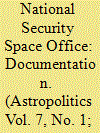| Srl | Item |
| 1 |
ID:
086540


|
|
|
|
|
| Publication |
2009.
|
| Summary/Abstract |
Space advocates adopted the tenet that the way to reduce the cost of space access is to fly reusable vehicles so development and production costs could be amortized over many flights. Some have also suggested that commercial suborbital flights, both for scientific payloads and for human space flight participants, may provide a path in which a revenue stream can be ultimately used to fund orbital and deep space operations. Some aspiring space launch providers (NewSpace) have incorporated in order to develop and fly such vehicles. This paper examines the economic and business conditions for reusable suborbital sounding rockets. Given current market size and pricing, the global nonmilitary suborbital sounding rocket market is less than 60 flights of perhaps 200-kilogram payloads annually at roughly $1 million each. High demand elasticity (increased demand with lowered prices) at a price of significantly less than $250 per kilogram of payload might increase the market to possibly 1500 flights annually. The business case for developing and flying reusable sounding rockets for this market cannot be closed with investor capital unless flight rates are markedly higher than at present. This paper discusses potential approaches to closing the business case.
|
|
|
|
|
|
|
|
|
|
|
|
|
|
|
|
| 2 |
ID:
086549


|
|
|
|
|
| Publication |
2009.
|
| Summary/Abstract |
Preventing resource conflicts in the face of increasing global populations and demands in the 21st century are high priorities for the United States Department of Defense. All solution options to these challenges should be explored, including opportunities from space. In 2007, the National Security Space Office's Advanced Concepts Office presented the idea of space-based solar power as a potential grand opportunity to address not only energy security, but environmental, economic, intellectual, and space security as well. First proposed in the late 1960s, the concept was last explored in NASA's 1997 "Fresh Look" Study. In the decade since this last study, advances in technology and new challenges to security have warranted a current exploration of the strategic implications of space-based solar power. For these reasons, the National Security Space Office sponsored a no-cost Phase 0 Architecture Feasibility Study of space-based solar power in 2007.
|
|
|
|
|
|
|
|
|
|
|
|
|
|
|
|
| 3 |
ID:
086541


|
|
|
|
|
| Publication |
2009.
|
| Summary/Abstract |
Solid rocket motors (SRMs) and liquid rocket engines (LREs) deplete the global ozone layer in various capacities. We estimate global ozone depletion from rockets as a function of payload launch rate and relative mix of SRM and LRE rocket emissions. Currently, global rocket launches deplete the ozone layer ?0.03%, an insignificant fraction of the depletion caused by other ozone depletion substances (ODSs). As the space industry grows and ODSs fade from the stratosphere, ozone depletion from rockets could become significant. This raises the possibility of regulation of space launch systems in the name of ozone protection. Large uncertainties in our understanding of ozone loss caused by rocket engines leave open the possibility that launch systems might be limited to as little as several tens of kilotons per year, comparable to the launch requirements of proposed space systems such as spaceplanes, space solar power, and space reflectors to mitigate climate change. The potential for limitations on launch systems due to idiosyncratic regulation to protect the ozone layer present a risk to space industrial development. The risk is particularly acute with regard to the economic rationale to develop low-cost, high flight rate launch systems.
|
|
|
|
|
|
|
|
|
|
|
|
|
|
|
|
| 4 |
ID:
086538


|
|
|
|
|
| Publication |
2009.
|
| Summary/Abstract |
Strategic Space and Defense is a global security conference for space and defense professionals organized and hosted on an annual basis by the Space Foundation. The editorial comments below highlight some of the key space-related issues discussed at Strategic Space and Defense 2008.
|
|
|
|
|
|
|
|
|
|
|
|
|
|
|
|
| 5 |
ID:
086539


|
|
|
|
|
| Publication |
2009.
|
| Summary/Abstract |
Raising questions about India-United States (U.S.) civilian space cooperation, arguments have been advanced that such cooperation will enable the growth of India's warhead integration capacity. This paper will demonstrate that concerns about India-U.S. civilian space cooperation leading to India's development of a Multiple Independently Retargetable Vehicle (MIRV) capability are unfounded. Despite the dual-use nature of space and missile related technologies, the analysis shows that the inference or deduction is flawed. The hypothesis adopted by proponents tends to treat integration of satellites and their orbital dispensation, and integration of multiple warheads and their delivery vehicles as though they are identical processes. Proceeding from limited evidence to substantiate their hypothesis that conflates satellite integration and warhead integration proponents have ended up obscuring and overlooking the fact that India already possesses incipient space technologies that are relevant to the development of MIRV-tipped missiles. This does not mean that it can immediately secure a full-fledged MIRV capability, because there are a range of other technical conditions that would affect its development of MIRV technology.
|
|
|
|
|
|
|
|
|
|
|
|
|
|
|
|